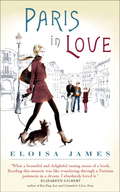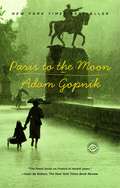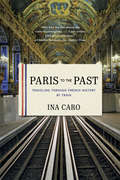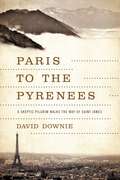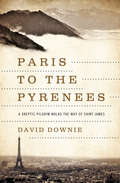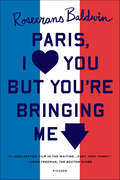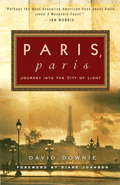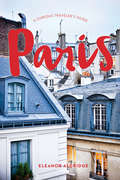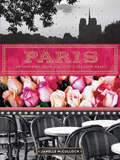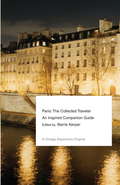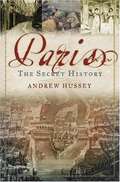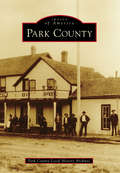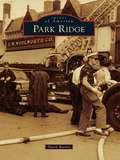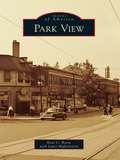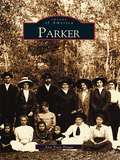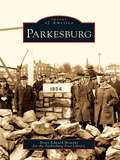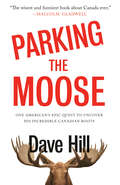- Table View
- List View
Paris in Love
by Nichole RobertsonThe author of Paris in Color narrows her scope, celebrating the French capital with alluring and romantic photographs of the city&’s come-hither reds. A pair of scarlet-rimmed coffee cups, two glasses of Bordeaux, light glowing rosily from a street lamp, a bouquet of bright red flowers—Nichole Robertson&’s follow-up to the beloved Paris in Color captures the hidden corners and secret moments that make Paris the most romantic city in the world. A love letter in rouge to the City of Light, Paris in Love is the perfect valentine for anyone who adores Paris! &“A beautiful ode that will leave you pining for Paris.&” —Lindsey Tramuta, author of The New Paris &“That magic feeling you get when you are falling in love with a person or place—in this case Paris!—is encapsulated in this stunning gem of a book.&” —Samantha Hahn, author of Well-Read Women &“We&’re smitten by Nichole Robertson&’s Paris in Love, which celebrates all things Parisian—especially crimson things, from raspberry tarts to scarlet mopeds, rosy begonias and glossy, berry-hued cafe chairs—in glorious photographs.&” —San Jose Mercury News
Paris in Love: A Memoir
by Eloisa James<P>In 2009, New York Times bestselling author Eloisa James took a leap that many people dream about: she sold her house, took a sabbatical from her job as a Shakespeare professor, and moved her family to Paris. <P>Paris in Love: A Memoir chronicles her joyful year in one of the most beautiful cities in the world. With no classes to teach, no committee meetings to attend, no lawn to mow or cars to park, Eloisa revels in the ordinary pleasures of life--discovering corner museums that tourists overlook, chronicling Frenchwomen's sartorial triumphs, walking from one end of Paris to another. <P>She copes with her Italian husband's notions of quality time; her two hilarious children, ages eleven and fifteen, as they navigate schools--not to mention puberty--in a foreign language; and her mother-in-law Marina's raised eyebrow in the kitchen (even as Marina overfeeds Milo, the family dog). <P>Paris in Love invites the reader into the life of a most enchanting family, framed by la ville de l'amour. <P><b>A New York Times Bestseller</b>
Paris in Love: A Memoir
by Eloisa JamesA New York Times Bestseller. After years of living vicariously through the heroines in her novels, bestselling author Eloisa James takes a leap that most of us can only daydream about. She sells her house, leaves her job as a Shakespeare professor, and packs her husband and two protesting children off to Paris. Grand plans are abandoned as she falls under the spell of daily life as a Parisienne exquisite food, long walks by the Seine, reading in bed, displays of effortless chic around every corner, and being reminded of what really matters in a place where people seem to kiss all the time. Against one of the world s most picturesque backdrops, she copes with her Italian husband s notions of quality time; her two hilarious children, ages eleven and fifteen, as they navigate schools not to mention puberty in a foreign language; and her formidable mother-in-law, Marina, who believes dogs should be fed prosciutto and wives should live in the kitchen. An irresistible love letter to a city that will make you want to head there, Paris in Love is also a joyful testament to the pleasures of savouring life.
Paris to the Moon: A Family In France (A\vintage Original Ser.)
by Adam GopnikParis. The name alone conjures images of chestnut-lined boulevards, sidewalk cafés, breathtaking façades around every corner--in short, an exquisite romanticism that has captured the American imagination for as long as there have been Americans. In 1995, Adam Gopnik, his wife, and their infant son left the familiar comforts and hassles of New York City for the urbane glamour of the City of Light. Gopnik is a longtime New Yorker writer, and the magazine has sent its writers to Paris for decades--but his was above all a personal pilgrimage to the place that had for so long been the undisputed capital of everything cultural and beautiful. It was also the opportunity to raise a child who would know what it was to romp in the Luxembourg Gardens, to enjoy a croque monsieur in a Left Bank café--a child (and perhaps a father, too) who would have a grasp of that Parisian sense of style we Americans find so elusive. So, in the grand tradition of the American abroad, Gopnik walked the paths of the Tuileries, enjoyed philosophical discussions at his local bistro, wrote as violet twilight fell on the arrondissements. Of course, as readers of Gopnik's beloved and award-winning "Paris Journals" in The New Yorker know, there was also the matter of raising a child and carrying on with day-to-day, not-so-fabled life. Evenings with French intellectuals preceded middle-of-the-night baby feedings; afternoons were filled with trips to the Musée d'Orsay and pinball games; weekday leftovers were eaten while three-star chefs debated a "culinary crisis."As Gopnik describes in this funny and tender book, the dual processes of navigating a foreign city and becoming a parent are not completely dissimilar journeys--both hold new routines, new languages, a new set of rules by which everyday life is lived. With singular wit and insight, Gopnik weaves the magical with the mundane in a wholly delightful, often hilarious look at what it was to be an American family man in Paris at the end of the twentieth century. "We went to Paris for a sentimental reeducation-I did anyway-even though the sentiments we were instructed in were not the ones we were expecting to learn, which I believe is why they call it an education."
Paris to the Past: Traveling through French History by Train
by Ina Caro"I'd rather go to France with Ina Caro than with ?Henry Adams or Henry James."--Newsweek In one of the most inventive travel books in years, Ina Caro invites readers on twenty-five one-day train trips that depart from Paris and transport us back through seven hundred years of French history. Whether taking us to Orléans to evoke the visions of Joan of Arc or to the Place de la Concorde to witness the beheading of Marie Antoinette, Caro animates history with her lush descriptions of architectural splendors and tales of court intrigue. "[An] enchanting travelogue" (Publishers Weekly), Paris to the Past has become one of the classic guidebooks of our time.
Paris to the Pyrenees
by David DowniePart adventure story, part cultural history, this &“enjoyably offbeat travelogue&” explores the phenomenon of the spiritual pilgrimage (Booklist). Driven by curiosity, wanderlust, and health crises, Downie and his wife walk across Paris on the old pilgrimage route Rue Saint-Jacques then trek about 750 miles south to Roncesvalles, Spain. The eccentric route would take 72 days on Roman roads and The Way of Saint James, the 1,100-year-old pilgrimage network leading to the sanctuary of Saint James the Greater in Spain. It is best known as El Camino de Santiago de Compostela - The Way for short. The object of any pilgrimage is an inward journey manifested in a long, reflective walk. For Downie, the inward journey meets the outer one. More than 20,000 pilgrims take the highly commercialized Spanish route annually, but few cross France. Downie had a goal: to go from Paris to the Pyrenees on age-old trails, making the pilgrimage in his own maverick way.
Paris to the Pyrenees: A Skeptic Pilgrim Walks the Way of Saint James
by David DowniePart adventure story, part cultural history, Paris to the Pyrenees explores the phenomenon of pilgrimage along the age-old way of Saint James Driven by curiosity, wanderlust, and health crises, David Downie and his wife set out from Paris to walk across France to the Pyrenees. Starting on the Rue Saint-Jacques, then trekking 750 miles south to Roncesvalles, Spain, their eccentric route takes 72 days on Roman roads and pilgrimage paths--a 1,100-year-old network of trails leading to the sanctuary of Saint James the Greater. It is best known as El Camino de Santiago de Compostela--"The Way" for short. The object of any pilgrimage is an inward journey manifested in a long, reflective walk. For Downie, the inward journey met the outer one: a combination of self-discovery and physical regeneration. More than 200,000 pilgrims take the highly commercialized Spanish route annually, but few cross France. Downie had a goal: to go from Paris to the Pyrenees on age-old trails, making the pilgrimage in his own maverick way.
Paris versus New York: A Tally of Two Cities
by Vahram Muratyan"In his witty, high-concept, high-colored flibook, Mr. Muratyan's thesis emerges playfully on every page: Vive la différence!" -- The New York TimesA beautiful gift book of a popular travel journal as told by a lover of Paris wandering through New YorkWhen Vahram Muratyan began his online travel journal, Paris versus New York, he had no idea how quickly it would become one of the most buzzed-about sites on the Internet—it garnered more than a million and a half page views in just a few months, and the attention of savvy online critics. Now Muratyan presents his unique observations in this delightful book, featuring visually striking graphics paired with witty, thought-provoking taglines that celebrate the special details of each city. Paris versus New York is a heartfelt gift to denizens of both cities and to those who dream of big-city romance.
Paris, Block by Block: An Illustrated Guide to the Best of France's Capital
by Cierra BlockParis is seen the world over as one of the most beautiful, romantic and iconic cities you can visit, and it has more places to eat and things to see than you could manage in a lifetime. Paris, Block by Block is the essential guide to the unmissable places to go, covering everything from restaurants to boutiques, galleries to parks, all illustrated with 50 of Cierra Block's distinctive maps. Each map starts with an idea – it might be, Where's the best croissant in Paris? What is the place everyone should visit in the Latin Quarter? Or, where can you lose hours people-watching? From there, Cierra has curated a list of the best places from Montmartre to The Marais, Champs Élysées to St-Germain, and has painted a charming accompanying map. Patisserie to fashion, the most impressive views to Seine-side activities, there really is something for everyone.The follow-up to 2022's London Block by Block and 2023's New York Block by Block, this book will be an inspiration for all, whether it's your first visit to the city, a seasoned traveller or an all-your-life local. That's the wonderful thing about Paris – there's always more to explore!
Paris, Block by Block: An Illustrated Guide to the Best of France's Capital
by Cierra BlockParis is seen the world over as one of the most beautiful, romantic and iconic cities you can visit, and it has more places to eat and things to see than you could manage in a lifetime. Paris, Block by Block is the essential guide to the unmissable places to go, covering everything from restaurants to boutiques, galleries to parks, all illustrated with 50 of Cierra Block's distinctive maps. Each map starts with an idea – it might be, Where's the best croissant in Paris? What is the place everyone should visit in the Latin Quarter? Or, where can you lose hours people-watching? From there, Cierra has curated a list of the best places from Montmartre to The Marais, Champs Élysées to St-Germain, and has painted a charming accompanying map. Patisserie to fashion, the most impressive views to Seine-side activities, there really is something for everyone.The follow-up to 2022's London Block by Block and 2023's New York Block by Block, this book will be an inspiration for all, whether it's your first visit to the city, a seasoned traveller or an all-your-life local. That's the wonderful thing about Paris – there's always more to explore!
Paris, I Love You but You're Bringing Me Down
by Rosecrans BaldwinA fresh, exhilarating take on one of the world's most popular topics—Paris, the City of Light!—by an acclaimed novelist Rosecrans BaldwinA self-described Francophile since the age of nine, Rosecrans Baldwin had always dreamed of living in France. So when an offer presented itself to work at a Parisian ad agency, he couldn't turn it down—even though he had no experience in advertising, and even though he hardly spoke French.But the Paris that Rosecrans and his wife, Rachel, arrived in wasn't the romantic city he remembered, and over the next eighteen months, his dogged American optimism was put to the test: at work (where he wrote booklets on breastfeeding), at home (in the hub of a massive construction project), and at every confusing dinner party in between. A hilarious and refreshingly honest look at one of our most beloved cities, Paris, I Love Youbut You're Bringing Me Down is the story of a young man whose preconceptions are usurped by the oddities of a vigorous, nervy metropolis—which is just what he needs to fall in love with Paris a second time.
Paris, Paris
by Diane Johnson David Downie Alison Harris"Beautifully written and refreshingly original... makes us see [Paris] in a different light." -- San Francisco Chronicle Book Review Swapping his native San Francisco for the City of Light, travel writer David Downie arrived in Paris in 1986 on a one-way ticket, his head full of romantic notions. Curiosity and the legs of a cross-country runner propelled him daily from an unheated, seventh-floor walk-up garret near the Champs-Elysées to the old Montmartre haunts of the doomed painter Modigliani, the tombs of Père-Lachaise cemetery, the luxuriant alleys of the Luxembourg Gardens and the aristocratic Île Saint-Louis midstream in the Seine.Downie wound up living in the chic Marais district, married to the Paris-born American photographer Alison Harris, an equally incurable walker and chronicler. Ten books and a quarter-century later, he still spends several hours every day rambling through Paris, and writing about the city he loves. An irreverent, witty romp featuring thirty-one short prose sketches of people, places and daily life, Paris, Paris: Journey into the City of Light ranges from the glamorous to the least-known corners and characters of the world's favorite city. Photographs by Alison Harris. "I loved his collection of essays and anyone who's visited Paris in the past, or plans to visit in the future, will be equally charmed as well." --David Lebovitz, author of The Sweet Life in Paris "[A] quirky, personal, independent view of the city, its history and its people"--Mavis Gallant "Gives fresh poetic insight into the city... a voyage into 'the bends and recesses, the jagged edges, the secret interiors' [of Paris]."-- DeparturesFrom the Trade Paperback edition.
Paris: A Book of Shapes (Hello, World)
by Ashley EvansonIntroducing Hello, World, an exciting new book series that pairs early learning concepts with colorful, stylish illustrations of cities around the world.Paris is a treasure trove of fascinating shapes: there are triangles at the Louvre Museum, rectangles at Notre-Dame Cathedral, arches at the Arc de Triomphe, and stars in a beautiful Parisian night sky. Explore shapes all over Paris in this gorgeous board book!
Paris: A Curious Traveler's Guide
by Eleanor AldridgeA fresh approach to visiting the “city of love” In the last few years, Paris has undergone a huge transformation. It’s fostered one of the coolest creative scenes in Europe, some of the continent’s best nightlife, and a “bistronomy” movement that has influenced dining around the globe. Yet while millennial travelers pour into the city, travel guides continue to focus on a staid checklist approach to Paris’s big attractions. There’s currently no book on the market aimed at younger (perhaps more budget-conscious) American visitors that truly captures the city’s revived energy—until this one. A Curious Traveler’s Guide to Paris will direct readers to the best paintings in the Centre Pompidou and tell them how to beat the lines at the Orangerie. It will guide them to quirky, little-known museums and secret squares. It will tell them how to find the city’s coolest speakeasies, best neo- bistros, and most unusual boutiques. Informative yet opinionated, it is an insider’s guide to Paris without pretension.
Paris: An Inspiring Tour of the City's Creative Heart
by Janelle McCulloch“McCulloch takes readers on a walking tour of eleven of Paris’s arrondissements, pointing out her favorite sights along the way.” —Holidays to EuropeTake a stroll through the real Paris with this beautifully photographed and gorgeously packaged book. Organized by arrondissement, Paris takes readers through the city’s most charming streets, revealing best-kept secrets and little gems at every turn: ateliers overflowing with notions, cafés with their neat rows of macarons, markets abundant with fresh flowers, shaded parks, and creative hotspots. Packed with vibrant color photographs that capture the spirit of Paris, the book is a beautiful object in its own right. The accessible writing invites readers to dip in and out and provides history and context for each spot on the journey. Visually rich and totally inspiring, Paris is a treasure for lovers of art, style, design, food, and, of course, Paris!“A sumptuous celebration and guidebook in one, this is the refreshing literary equivalent of taking Dom Pérignon with Coupe Hélène. Janelle McCulloch isn’t just a style guru; she is an informed omnivore of culture.” —The Varnished Culture“Her easy-reading texts are also filled with insider tips on where to go and what to see, giving up some of the city’s best-kept secrets.” —Culture Trip
Paris: The Collected Traveler
by Barrie KerperEach edition of this unique series marries a collection of previously published essays with detailed practical information, creating a colorful and deeply absorbing pastiche of opinions and advice. Each book is a valuable resource -- a compass of sorts -- pointing vacationers, business travelers, and readers in many directions. Going abroad with a Collected Traveler edition is like being accompanied by a group of savvy and observant friends who are intimately familiar with your destination.This edition on Paris features:Distinguished writers, such as Mavis Gallant, Barbara Grizzuti Harrison, Herbert Gold, Olivier Bernier, Richard Reeves, Patricia Wells, Catharine Reynolds, and Gerald Asher, who share seductive pieces about Parisian neighborhoods, personalities, the Luxembourg Gardens, Père-Lachaise and other monuments, restaurants and wine bars, le Plan de Paris, and le Beaujolais Nouveau. Annotated bibliographies for each section with recommendations for related readings. An A-Z "renseignements pratiques" (practical information) section covering everything from accommodations, marches aux puces (flea markets), and money to telephones, tipping, and the VAT.Whether it's your first trip or your tenth, the Collected Traveler books are indispensable, and meant to be the first volumes you turn to when planning your journeys.From the Trade Paperback edition.
Paris: The Essential Insider's Guide (City Secrets)
by Robert Kahn Fiona KahnCity Secrets Paris brings together the recommendations of artists, writers, historians, architects, chefs, and other experts whose passionate opinions and highly informed perspectives illuminate well-known sites as well as overlooked treasures. These expert travel companions share their favorite little-known places and activities, including restaurants, cafés, art, architecture, shops, outdoor markets, strolls, day-trips, and all manner of cultural and historic landmarks.
Paris: The Secret History
by Andrew HusseyThis book describes daily life in Paris throughout its history: a history of the city from the point of view of the Parisians themselves.
Park County
by Park County Local History ArchivesCreated in 1861, Park County is one of Colorado's original 17 territorial counties. It is named after South Park, which is the vast, high alpine valley at the county's center. By the time the first fur trappers and explorers arrived in the early 1800s, Ute Indians had long visited the area to hunt the mountain valleys and fish the trout-filled streams. In 1859, prospectors discovered gold along Tarryall Creek, ushering in a mining boom that gave rise to dozens of boisterous mining camps. Ranchers soon followed, taking advantage of the nutritious native grasses and raising cattle to feed hungry miners, often under harsh conditions. By the 1880s, the Denver, South Park & Pacific and Colorado Midland Railroads arrived, spurring the growth of new towns and opening new markets for Park County's minerals, hay, ice, lumber, and cattle. As mining waned, tourism emerged as a major economic force attracting visitors eager to experience Park County's authentic character and stunning natural beauty.
Park Life: Around the World in 50 Parks
by Tom ChesshyreIf the pandemic has taught us one thing, it's that people love parks Wherever we are in the world, urban parks are places where we can find calm amid the chaos. With fondness and humour, travel writer Tom Chesshyre recalls 50 of his favourite urban parks from across the world, in a love letter to the green escapes that bring us joy in our cities.
Park Ridge (Images of America)
by Dave BarnesIn 1835, immigrants began to arrive from New York and New England to the area first called Pennyville, later renamed Brickton to reflect its leading industry, then finally incorporated as the Village of Park Ridge in 1873. The name originates from the village's park-like setting and an erroneous belief that the ridge at Johnston's Circle--today the three-way intersection of Touhy, Prospect, and Northwest Highway--was the highest point in Cook County. Notable names associated with Park Ridge include Secretary of State Hillary Clinton and actor Harrison Ford, who both attended Maine East High School; Chicago Cubs great Ron Santo, who operated a popular pizzeria in town; and painter Grant Wood, whose American Gothic is one of the 20th century's great works of Americana. Anchored by the landmark Pickwick Theater, a fine example of art deco architecture built in 1928, downtown Park Ridge has changed much over the years, a transformation captured so well in the pages of this book.
Park View
by Kent C. Boese Lauri HafvensteinThe Park View neighborhood, nestled in the northeastern corner of Washington's Ward One and bordering the Soldiers' Home and Howard University, is historically linked to its main thoroughfare, Georgia Avenue. Located on high ground in close proximity to downtown, the land was home to farms and country retreats throughout the 19th century. Park View's location on a streetcar line leading to the Washington waterfront hastened development when the city experienced a housing boom at the start of the 20th century. Builders, including Harry Wardman and Edgar S. Kennedy, constructed entire streets of row houses to meet the demand. Between 1948 and 1950, the community experienced rapid demographic changes, resulting in a solidly African American community. Civil unrest in the late 1960s dramatically impacted Georgia Avenue, with many businesses deciding to leave the corridor rather than stay. The opening of Metro stations at Columbia Heights and Georgia Avenue in 1999 reinvigorated the community and laid a foundation for new investment and development in the area.
Parker (Images of America)
by Ann Pratt HouptParker is a community shaded by live oaks on St. Andrews Bay in the Florida Panhandle, and its history dates back to the early 1800s. This pictorial treasure celebrates the community's heritage, people, places, and events in a variety of vintage photographs that bring to life the birth and growth of this once nameless, sleepy fishing village. Highlighted in this volume are unique images of the early settlers and their descendants; fishing and boat building; the Parker School and the community's churches; the Paper Mill and Tyndall Air Force Base; and treasured pastimes and events.
Parkesburg (Images of America)
by Bruce Edward Mowday Parkesburg Free LibraryParkesburg is located in Chester County, one of William Penn's original three counties. The town was first known as the Fountain Inn, after a 1730s tavern, and the tavern later became the town's first post office. Fountain Inn was renamed Parkesburg after prominent politician John G. Parke. A number of important businesses had connections to Parkesburg, including the Philadelphia and Columbia Railroad, which was later a part of the Pennsylvania Railroad. In 1872, Horace Beale moved his ironworks from nearby Hibernia to Parkesburg and named it the Parkesburg Iron Company. The company had a competitive baseball team, and major?leaguers such as Babe Ruth played against the team. The town also was home to one of the first airfields in the county.
Parking the Moose: One American's Epic Quest to Uncover His Incredible Canadian Roots
by Dave HillA quarter-Canadian from Cleveland explores his roots--and melts your face with joy.There's an idea most Americans tend to learn as children. The idea that their country is the "best." But this never stuck with Dave Hill, even though he was born and raised in Cleveland, Ohio. His grandfather, you see, was from Canada (Clinton, Ontario, to be exact). And every Sunday at dinner he'd remind Dave and anyone else within earshot that it was in fact Canada, this magical and mysterious land just across the mighty Lake Erie, that was the "best."It was an idea that took hold. While his peers kept busy with football, basketball and baseball, hockey became the only sport for Dave. Whenever bacon was served at home, he'd be sure to mention his preference for the Canadian variety. Likewise, if a song by Triumph came on the radio, he'd be the first to ask for it to be cranked up as loud as it would go. And he was more vocal about the vast merits of the Canadian healthcare system than any nine-year-old you'd ever want to meet. (That last part is a lie, but hopefully it makes the point that he was so into Canada that it was actually kind of weird.)In later years he even visited Canada a couple of times. But now, inspired by a publisher's payment of several hundred dollars (Canadian) in cash, he has travelled all over the country, reconnecting with his heritage in such places as Montreal, Moose Jaw, Regina, Winnipeg, Merrickville and of course Clinton, Ontario, meeting a range of Canadians, touching things he probably shouldn't and having adventures too numerous and rich in detail to be done justice in this blurb.The result, he promises, is "the greatest Canada-based literary thrill ride of your lifetime."


